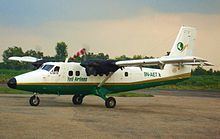Summary Under investigation Crew 3 Date 15 December 2010 Total fatalities 22 (all) Locations Nepal, Srichaur | Passengers 19 Survivors 0 Operator Tara Air Survivor 0 | |
 | ||
Site Bilandu Forest, Shreechaur, Okhaldhunga District, Nepal Aircraft type de Havilland Canada DHC-6 Twin Otter Destinations Tribhuvan International Airport, Kathmandu, Nepal Similar Tajik National Guard hel, Conair Aviation Flight 448, 2010 Air Service Berlin Do, Zalingei Tarco Airlines A, 2010 Cameroon Aéro Serv | ||
On 15 December 2010, a Tara Air de Havilland Canada DHC-6 Twin Otter crashed in Nepal shortly after take-off on a domestic passenger flight between Lamidanda Airport, Lamidanda, and Tribhuvan International Airport, Kathmandu. The wreckage of the aircraft, registration 9N-AFX, was found in Bilandu forest near the village of Shreechaur, Okhaldhunga District, Nepal, the morning after the crash. All 19 passengers and three crew aboard were killed in the crash. There was initial speculation that bad weather or the overloading of the aircraft might have caused the crash. An investigation into the crash was launched by Nepalese authorities after the accident site was located.
Contents
Flight
Five minutes after taking off from Lamidanda Airport, Lamidanda, at 15:08 local time, the left wing of the aircraft impacted land and the DHC-6 crashed. The aircraft was reportedly scheduled to land in Kathmandu at around 15:35, 35 minutes after departing Lamidanda, but it did not. All 19 passengers and three crew members aboard were killed in the crash.
Search operation
Helicopters searched for the wreckage of the aircraft on the day of the crash, but was called off during the night because of poor visibility, even though night vision equipment was installed on the helicopters. The day after the crash, the Nepalese Army located the wreckage in Okhaldhunga, Nepal, at an altitude of approximately 2,700 metres (8,900 ft). All 22 bodies were recovered by rescuers. The wreckage of the aircraft reportedly covered 200 square metres (2,200 sq ft), and, according to a police spokesperson, had "broken up completely".
Initial speculation
There was initial speculation that bad weather caused the crash. The chief executive of Tara Air, Vijay Shrestha, said: "It showed poor visibility at different levels of the atmosphere. Thick haze at lower levels and as thick a cloud higher up could have caused poor visibility." There was also speculation that the aircraft could have been overloaded, but Shrestha refuted these allegations. "The aircraft's maximum take-off weight is 12,500 pounds, while the Twin Otter’s take-off weight that crashed killing all 22 on board was 12,280 pounds," he said. "So it was underweight by 220 pounds, the allegation is wrong."
Investigation
An investigation into the crash was launched after the accident site was located. Nepal's Ministry of Tourism and Civil Aviation formed a group of five investigators to find the cause of the crash. The five were ordered to present a report on the accident by 90 days after the crash occurred. The cockpit voice recorder was recovered from the scene of the accident, and, as of 24 December 2010, was to be sent to India or Europe for analysis.
A separate investigation was also started into alleged irregularities, which, according to The Himalayan Times included "carrying passengers by issuing tickets in other's name, not verifying identity while checking-in passengers and the process of immigration of the foreign nationals who lost their lives in the crash." Police arrested the general manager of a travel agent based in Kathmandu over suspicions of tax evasion during the sale of tickets for the flight.
